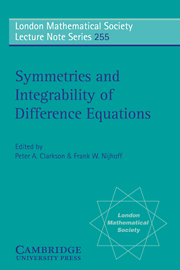Book contents
- Frontmatter
- Contents
- Preface
- List of Participants
- 1 Partial Difference Equations
- 2 Integrable Mappings
- 3 Discrete Geometry
- Discrete conformal maps and surfaces
- The Bäcklund transformation for discrete isothermic surfaces
- Integrable discrete geometry with ruler and compass
- Self-dual Einstein spaces and a discrete Tzitzeica equation, a permutability theorem link
- 4 Asymptotic Analysis
- 5 Discrete Painlevé Equations
- 6 Symmetries of Difference Equations
- 7 Numerical Methods and Miscellaneous
- 8 Cellular Automata
- 9 q-Special Functions and q-Difference Equations
- 10 Quantum Aspects and Yang-Baxter Equations
The Bäcklund transformation for discrete isothermic surfaces
Published online by Cambridge University Press: 04 August 2010
- Frontmatter
- Contents
- Preface
- List of Participants
- 1 Partial Difference Equations
- 2 Integrable Mappings
- 3 Discrete Geometry
- Discrete conformal maps and surfaces
- The Bäcklund transformation for discrete isothermic surfaces
- Integrable discrete geometry with ruler and compass
- Self-dual Einstein spaces and a discrete Tzitzeica equation, a permutability theorem link
- 4 Asymptotic Analysis
- 5 Discrete Painlevé Equations
- 6 Symmetries of Difference Equations
- 7 Numerical Methods and Miscellaneous
- 8 Cellular Automata
- 9 q-Special Functions and q-Difference Equations
- 10 Quantum Aspects and Yang-Baxter Equations
Summary
Abstract
Discrete isothermic surfaces has been recently introduced by Bobenko and Pinkall. We construct the Bäcklund transformation which is an analogue of the classical Darboux–Bianchi transformation for smooth isothermic surfaces. We use the Sym formula expressing explicitly the immersion in terms of the wave function of the associated 4Ø4 Lax pair. The Lax pair can be conveniently rewritten in terms of the Clifford algebra C(4,1). The 3-dimensional net generated by subsequent Bäcklund transformations forms a triply orthogonal system of discrete isothermic surfaces.
Introduction
The discrete geometry has quite a long history, see. Recently one can observe the growing interest in the subject. Discrete surfaces can be defined as maps Z2 → Rn. Usually one is interested in maps characterized by some nice geometric properties.
In the present paper we consider discrete isothermic surfaces. We apply the soliton surfaces approach (see also) based on the so called Sym formula. The same approach turned out to be very useful in the continuous case. Using the Clifford algebra C(4,1) we construct the Bäcklund (or Darboux-Bianchi) transformation generating discrete isothermic surfaces. In this way we obtain 3 families of mutually orthogonal discrete isothermic surfaces. Two families consist of standard discrete isothermic surfaces (cross ratio for any elementary quadrilateral is negative) and the third one consists of “twisted isothermic surfaces” (cross ratio is positive).
- Type
- Chapter
- Information
- Symmetries and Integrability of Difference Equations , pp. 109 - 121Publisher: Cambridge University PressPrint publication year: 1999
- 4
- Cited by

